Downvotes and User Retention
Downvotes are perhaps the most controversial topic in the Hive space. They have been a contentious issue since the beginning of Steem back in 2016 and remain so to this day. Detractors consider them to be a form of censorship and that their existence is contrary to the widely stated goal of censorship resistance. Proponents claim that they are a necessary evil, without which the network would devolve into a free for all where the rewards pool exists only to line the pockets of those willing to farm them as aggressively as possible. Downvotes are so contentious that there has even been a fork of Steem created with the stated goal of eliminating censorship by having a downvote-free chain.
It should come as no surprise then that there is also a widespread belief that downvotes contribute to the low levels of user retention that Hive experiences. The purpose of this post is to break down that idea into something testable, and if possible to try to answer it with data.
Downvote Hypotheses
When we think about measuring downvotes, it quickly becomes clear that we probably need to treat it as not just one hypothesis but a category of closely related hypotheses. What is it about downvotes that would cause people to leave? Is it the removal of rewards and a sense of loss? Is it the feeling of having that post you worked hard on rejected? Is it the perception that downvotes give of a community rife with drama and conflict?
Thinking along those lines, here are some possible metrics we could use to measure downvotes. Each metric attempts to focus more closely on a precise potential cause of users leaving.
- The number of downvotes every day
- The number of downvotes that substantially remove potential rewards from a post (ie. removing more than a few pennies from a post).
- The number of whale downvotes (ie. that could fully or nearly wipe out a posts rewards).
- The number of downvotes directed towards new users.
- The number of downvotes directed towards highly popular users.
- The number of heavy downvotes towards new users.
etc.
These are just a few examples of how we could try and examine the data, I am sure that readers can come up with more variations along these lins.
In this post I will just look at the first three, but it may be worthwhile to examine related ideas in the future.
Measuring Downvotes
1. Downvotes Per Day
The first metric is the simplest to measure. Below is a chart of downvotes per day.
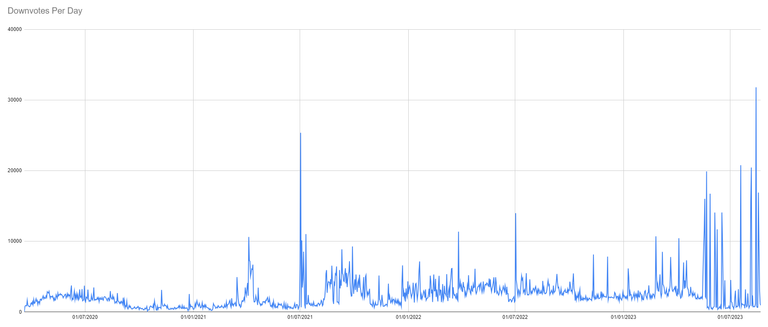
Here are a few more charts that provide more context in terms of how downvotes fit into voting overall.
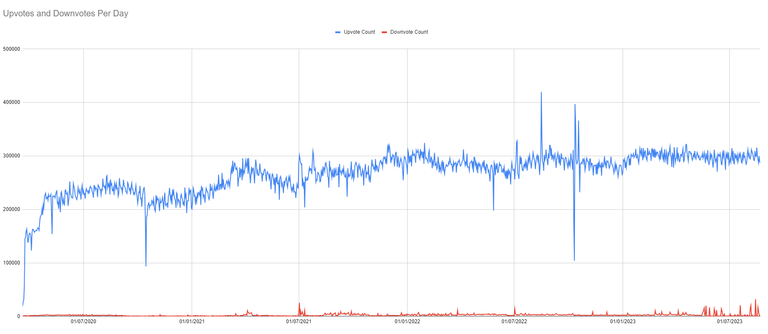
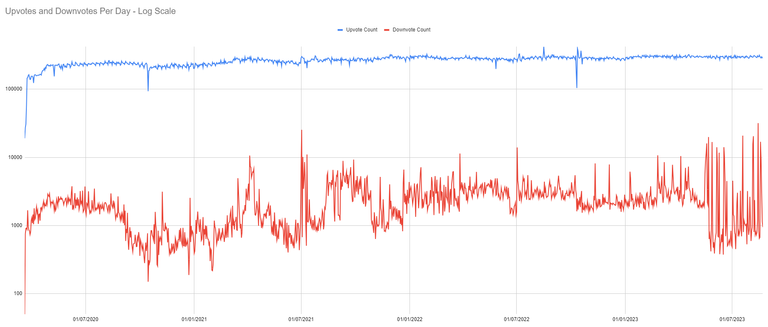
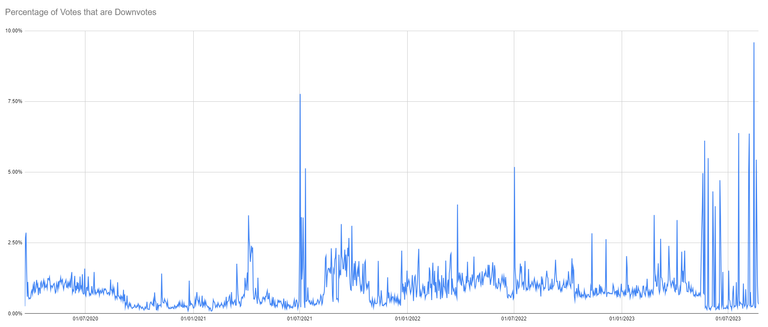
As you can see, downvotes usually represent a tiny proportion of all votes, but they are much more variable and can sometimes go nearly as high as 10% of votes overall.
2. Heavy Downvotes Per Day
As far as I'm aware, HiveSQL does not have any table which tracks the full monetary value of a vote, be it an upvote or downvote. It keeps a record of the weight, a number between 10,000 and -10,000, but the effective value of a vote depends on more information, the voting power of the account at that time, how much stake the user has at that time and also how much reward is applied per r-shares. To get the full value, you have to recalculate the state of the chain, which is too complex for my purposes here.
I can however use a bit of a hack. A user who is earning substantial curation rewards also has a substantial downvote. Curation rewards are tracked directly in HiveSQL, so I can use that as a proxy to find users with a substantial downvote.
I define Heavy Downvotes as those downvotes with weight of at least 50% by accounts whom are earning an average curation reward of 1000 Vests (typically about 0.5 Hive) 7 days later from their upvotes. This will miss users who are not curating and it may also miscategorize some users who curate with lower percent rates, but I still expect it would be a high level of coverage. Below is a chart of "heavy downvotes" per day.
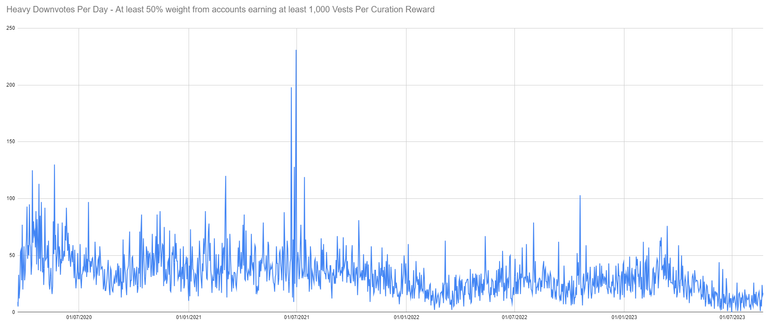
3. Whale Downvotes Per Day
Finally, whale downvotes are measured in the same way, but merely increasing the required level of curation rewards, which are proportional to stake. I treat users earning at least 10,000 Vests (about 5 Hive) per curation reward as whales here.
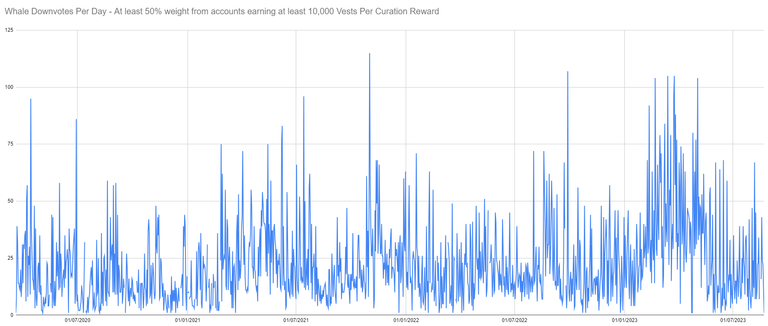
Analysis
If users go inactive because of downvotes, we would expect that these metrics have predictive value towards future user activity. This means we can use Granger Testing to test these hypotheses. If you are interested in the methodology, my post on Splinterlands and Hive Price goes into detail.
First the datasets must be determined to be stationary. All three are determined to be stationary with Augmented Dickey-Fuller tests.

Daily changes in active user counts have been determined to be stationary in prior posts.
This allows us to proceed to Granger Tests. I test the number of downvotes, heavy downvotes and whale downvotes against change in user activity per day to determine if any have predictive value. Results are below.

There are no statistically significant results in this data.
Conclusion
Using direct measurements of downvotes per day as well as a proxy measurement for "heavy" and "whale" sized downvotes per day, I find no statistically significant impact on user activity.
This doesn't completely rule out downvotes as a factor in user retention, but it may require refining the hypothesis and focusing on a more granular set of data, such as downvotes on new users. However, in general the data presented here does not support the hypothesis that downvotes contribute to Hive's user retention problem.
I could be wrong, but I think to potentially see the impacts you'd need to establish a clearer test on the impact of downvotes on a user by user basis.
For instance, a control might be to look at a users Posting rate before receiving a downvote, then find another sampling of users with a similar posting frequency.
Then, look at the posting rate after the downvotes - this would potentially tell you if the downvote had an effect on those users.
The control would be to see other users with similar posting rates but without receiving the downvote to see if the downvote might have had a correlation to a change in posting rate.
Outcomes could be a decrease in posting rate in the period after the downvote, no change, or even an increase.
I think that kind of comparison might be important to be able to measure for potential opportunity costs that downvotes may be causing.
I could be wrong, but that should let us see "does downvoting cause people to stop participating"
The problem with this test design is that it's very hard for the samples to be genuinely independent. Without performing an actual controlled experiment, ie. setting the population and introducing the variable yourself, attempts to sample users who received the treatment (downvotes in this case) basically always involve sampling bias - there is some reason this user was downvoted and one other was not, and this is difficult to control for.
The advantage of the method above with granger analysis is that it works reasonably well retrospectively, by not making such attempts to sample - looking at the whole population.
That makes sense.
There would still be some level of a correlation you could detect though right?
The sampling bias would mainly cause a problem for being sure if the correlation indicated causation right?
But it could at least be seen - does downvoting correlate to users not participating anymore. There could still be a question as to whether that's a good thing, a bad thing, or if the downvote was likely the cause or not.
Keep in mind... this is all with only the vaguest of understandings of proper controls and testing on what you're describing - fully aware that my thoughts can be full of blindspots :)
You could see such things as those users who receive downvotes being more likely to leave, but there are many forms of sampling bias that could end up giving you that same conclusion mistakenly. It would take a greater degree of rigor to control for such things. Possible to do but takes more work and expertise.
It might be worth doing these kinds of tests anyway, because it can be interesting to examine even while being aware of the limitations.
This site gives some interesting DV stats. It's some of the biggest accounts they get the most. I think that's partly down to long-running feuds between old/big accounts.
We do see a lot of new accounts set up to try and exploit Hive with plagiarised content and other schemes, so those are likely to get DVs as soon as they are spotted. People can track who is voting them up and they may have scripts to 'follow the money'. You need some reasonable HP to earn that way and it can be tracked.
I just hate to see people put off when they attract DVs through actual ignorance of what is acceptable.
I’ve known many users that stopped using HIVE due to the downvotes they were receiving. Unfortunately, I think a lot of the large stakeholders have a gate-keeping mentality
I cannot contradict individual cases, but among the population as a whole, it is not seen in the data. The vast majority of users give up within just a few days or weeks, so users who leave because of downvotes would likely be a small minority among the noise of others leaving for reasons that they face more immediately after joining.
I also have not examined the effect on power downs or the Hive price, perhaps the harms of downvotes could show up there instead.
I think Bear markets takes the major blame, also over-expectations(users expecting too much from web3 in a short time). In my own case it's life lol, life happened to me and I can't even settle to come back to Hive or think of things to blog about.
My thoughts😊
Hey Olu! How are you? Did you ever manage to make it on the education plan you told me about?
Oh, I had so many huge setback. I'll ping you on X/twitter. But I'm thankful for life 🙏
PS: tried reaching you on my new Twitter/x, couldn't msg you, I'm not verified. My main handle is currently suspended, new one is @slydeblack
Have you seen that there is a built in chat feature on peakd.com?
Just checking it out, so many improvement
I am sure it a problem but I don't think it's a big reason, I think if someone has no guidance it's very hard to even earn on hive in the first place. But I do think the downvotes can be problematic especially if someone with lots of hive power is not being reasonable I was thinking of maybe establishing a hive union and one of the things it would do is fight unreasonable downvotes
I don't think so, People are leaving hive for not having proper knowledge. Initiative like Hivelearners are helping users like me.
I would like to say here that this is true when a person works so hard to create a post, go to beautiful places to take pictures and when our post is hidden the way all my previous posts are hidden. It has been done, so I was very worried for two days and my heart did not want to work, then later I again decided that I will make a new start and now I have started working again. I also think that this system should be abolished. People should be warned first and explained that you can't do it like this. If you do it, it can be very dangerous for you. It is lost because all the posts that are there are my hide.
This is a great study and it is good to know that on a grand scale downvotes are not significant. But would we be able to compare active users for the last 90 days. And users who have been inactive in the same time period. That could give us an idea of how downvotes affect user inactivity.
I find it an interesting way to seriously try to explain the situation of downvotes.
Stay !ALIVE
!LOLZ
!GIF downvote!
!MEME
!PGM
Via Tenor
BUY AND STAKE THE PGM TO SEND A LOT OF TOKENS!
The tokens that the command sends are: 0.1 PGM-0.1 LVL-0.1 THGAMING-0.05 DEC-15 SBT-1 STARBITS-[0.00000001 BTC (SWAP.BTC) only if you have 2500 PGM in stake or more ]
5000 PGM IN STAKE = 2x rewards!
Discord
Support the curation account @ pgm-curator with a delegation 10 HP - 50 HP - 100 HP - 500 HP - 1000 HP
Get potential votes from @ pgm-curator by paying in PGM, here is a guide
I'm a bot, if you want a hand ask @ zottone444
@demotruk! You Are Alive so I just staked 0.1 $ALIVE to your account on behalf of @ pedrobrito2004. (2/10)
The tip has been paid for by the We Are Alive Tribe through the earnings on @alive.chat, feel free to swing by our daily chat any time you want, plus you can win Hive Power (2x 50 HP) and Alive Power (2x 500 AP) delegations (4 weeks), and Ecency Points (4x 50 EP), in our chat every day.

lolztoken.com
He always wants everything meow.
Credit: reddit
@demotruk, I sent you an $LOLZ on behalf of pedrobrito2004
(2/4)
Credit: anthonyadavisii
Earn Crypto for your Memes @ HiveMe.me!
Congratulations @demotruk! You have completed the following achievement on the Hive blockchain And have been rewarded with New badge(s)
Your next payout target is 38000 HP.
The unit is Hive Power equivalent because post and comment rewards can be split into HP and HBD
You can view your badges on your board and compare yourself to others in the Ranking
If you no longer want to receive notifications, reply to this comment with the word
STOPCheck out our last posts: